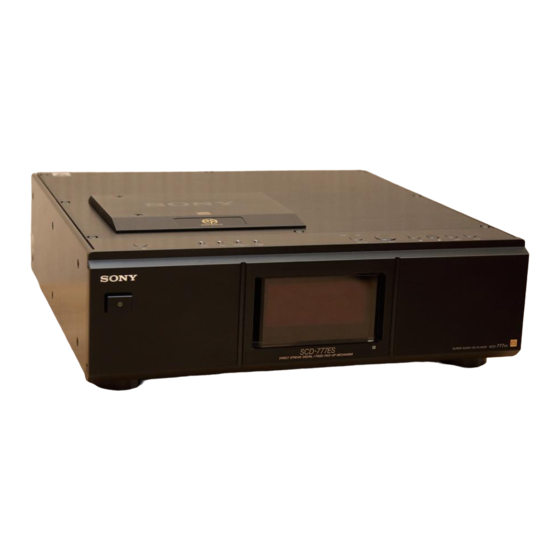Summary of Contents for Sony SCD-1
- Page 1 SCD - 1 SCD - 777ES & S u p e r A u d i o C D / C D P l a y e r s Technical Background...
-
Page 2: Table Of Contents
5.1. SCD-1 Features ........ -
Page 3: Introduction
(DSD) encoding gives music a freshness and presence unmatched by any other audio technology. To demonstrate this new format to the fullest, Sony has built two landmark compo- nents: the SCD-1 and SCD-777ES Super Audio CD™/CD players. In creating these players, Sony discarded many preconceived notions about digital audio and digital music reproduction. -
Page 4: Technology
Digital Noise Pickup Filter Shaper PLM Pulse & ACP & ƒs 16 bit RF Amplifier Reference Clock Digital Filter Generator [ƒs = 44.1kHz] The SCD-1 and SCD-777ES incorporate circuitry to handle both Compact Disc and Super Audio Compact Disc signals. -
Page 5: Fixed Pickup Mechanism
2.2. Fixed Pickup Mechanism. This Fixed Pickup design—first used in Sony's critically-acclaimed CDP-XA7ES Compact Disc Optical playback systems require motor servos, player—has been further refined by highly tracking servos and focus servos to maintain advanced sub-assemblies: accurate playback. Unfortunately, the laser out- •... -
Page 6: Dual Discrete™ Optical Pickup
(track pitch) of CD. The pits themselves are also half as long. As a result, SACD requires absolute precision in playback. That's why the SCD-1 and SCD-777ES employ an exclusive Sony Digital Signal Processor (DSP) to control spindle motor, tracking and focus ser- vos. -
Page 7: Dsd™ Decoder
In practice, the DSD pulse streams is the job of the DSD decoder. signal benefits from some highly specialized pro- Another Sony-built LSI, the DSD decoder first cessing. To preserve the maximum accuracy of reads the invisible watermark—a key anti-piracy the DSD pulses, our design program identified feature—and then decodes the incoming data. - Page 8 The first element in this reproduction system is The real world is a different place. In reality, at ACP. Sony designed ACP to overcome one the MegaHertz speeds of DSD encoding, ICs practical limitation in decoding the Direct Stream permit some switching distortion. Leading and Digital pulse train.
-
Page 9: Synchronous Time Accuracy Controller (S-Tact)
As a result, the distortion is easy to remove in subsequent processing. The ACP system establishes extraordinary precision on the amplitude axis, a crucial factor in the audio performance of the SCD-1 and SCD-777ES players. 2.8. Synchronous Time Accuracy Controller (S-TACT). - Page 10 D/A converter, noise is not mixed in Improved time axis precision and improved sound quality Conventional circuits place the clock generator on the same chip as high-speed digital operations—exposing the clock pulses to harmful noise. Sony's S-TACT circuit isolates the clock generator from digital noise.
-
Page 11: Current Pulse D/A Converter
Pulse D/A converter. Vdd/2 Digital noise vibrates Vdd/2 threshold voltage Input A familiar feature of high-end Sony CD players, the Current Pulse D/A changes the incoming Output train of voltage pulses to a train of current puls- Influencing the Vdd/2 threshold voltage causes the timing to shift es. -
Page 12: Low-Pass Filter
The result is smooth, open, non-fatiguing sound with exceptional definition and dynamics. Signal Flow Signals pass through active elements GIC Type Low-Pass Filter Fig. 12 Characteristics of Low-Pass Filter Used in SCD-1 Signals do not pass through any active elements Signal Flow -100 100k... -
Page 13: Vc24 Digital Filter
20 kHz, with the greatest possi- process from laser to analog output. However, ble suppression of ultrasonic noise. the SCD-1 and SCD-777ES are also CD players. • df-1. This setting incorporates smoothing inter- Compact Discs get the benefit of most of the polation. -
Page 14: Construction
Sony was equally careful in the physical copper plate. arrangement of circuits in the chassis. The main circuit board—which includes the DSP servo LSI, RF processing LSI and system control —is positioned directly underneath the fixed... -
Page 15: Power Supply Block
A remote resolve even the most subtle musical informa- tion, the SCD-1 and SCD-777ES were designed power switch, for example, minimizes intertwin- to restrict even the most subtle forms of distor- ing of the primary AC wiring—restricting it to a... -
Page 16: Insulator Feet
The SCD-1 is distinguished by sophisticated 5-piece insulator feet. The upper foot is made of a high-carbon cast iron that offers high attenuation. -
Page 17: Operation
Sony preamplifier and receiver remote 4.4. Text. controls. To prevent mistaken operation in sys- tems that already include a Sony CD player, the Just as Compact Disc offers a CD TEXT™ SACD player and remote can be switched to option, Super Audio Compact Disc has a "CD2"... -
Page 18: Features And Specifications
5. Features and Specifications. 5.1. SCD-1 Features. • Plays Super Audio Compact Discs and • Die-cast aluminum spindle motor with sapphire Compact Discs and ruby bearings • New Direct Stream Digital (DSD) encoding • Floating suspension transport with rubber eliminates the distortions of decimation and... -
Page 19: Scd-777Es Features
• 24-bit Variable Coefficient digital filter for • Text display for compatible CDs and SACDs CD playback • Remote Commander ® wireless remote control 5.3. Specifications. SCD-1 SCD-777ES Super Audio Compact Disc Frequency Range 2-100,000 Hz 2-100,000 Hz Frequency Response... - Page 20 Sony, CD TEXT, DSD, Direct Access, Direct Stream Digital, Dual Discrete, Remote Commander, Super Audio CD, the DSD logo and the Super Audio CD logo are trademarks of Sony. Teflon is a trademark of DuPont. Sony Electronics Inc.






